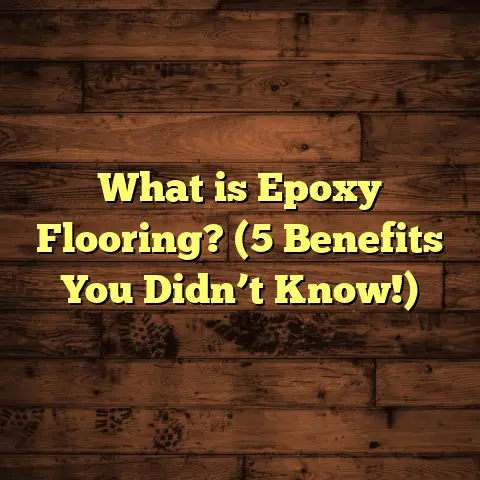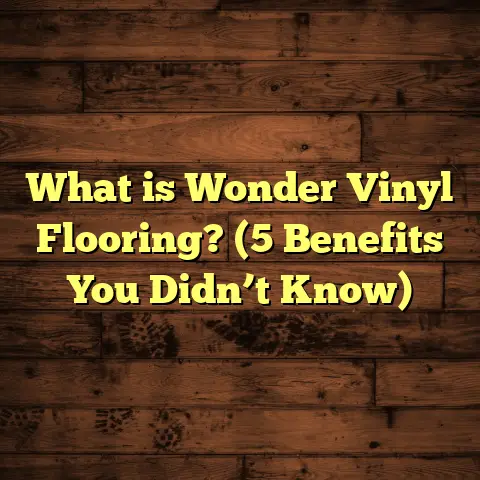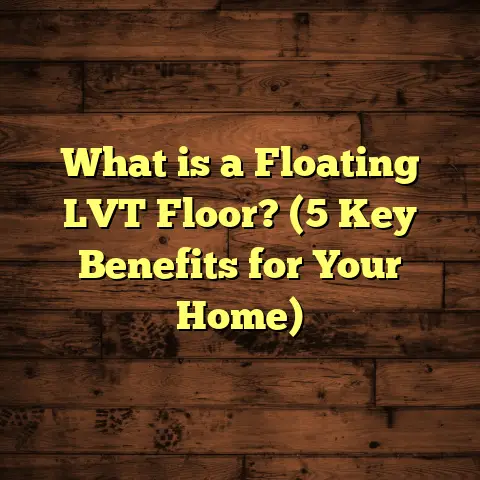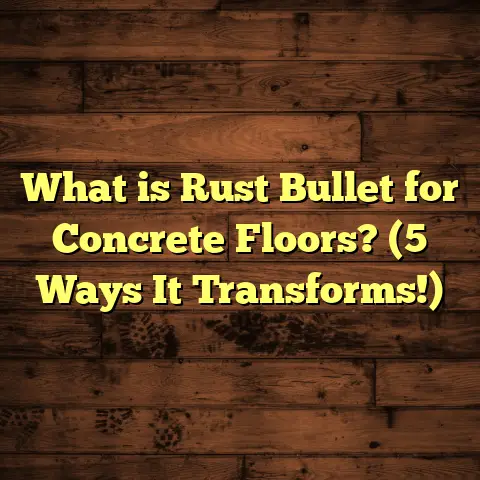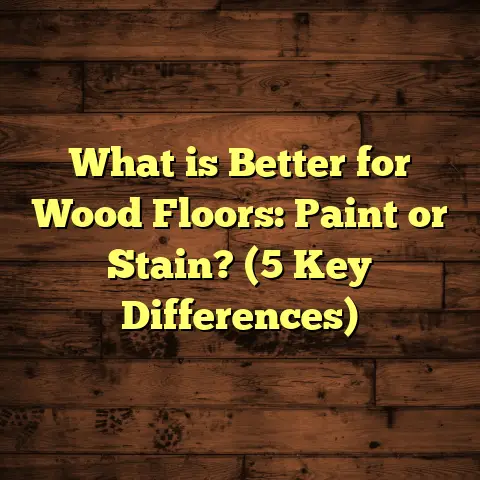What is Vinyl Plank Flooring? (5 Reasons It’s a Game-Changer)
I remember the first time I installed vinyl plank flooring in my home. It was one of those moments when I realized that not every flooring option needs to be complicated or expensive to look amazing and perform well. The ease of use surprised me. I didn’t need a professional installer or fancy tools. The planks just clicked together smoothly, and before I knew it, I had a fresh new floor that looked like real wood but didn’t come with the headaches of traditional hardwood. If you’ve ever dealt with the hassle of tiling or sanding hardwood floors, you’ll know how refreshing this simplicity is.
What is Vinyl Plank Flooring?
Let’s start with the basics. So, what exactly is vinyl plank flooring? At its most straightforward, vinyl plank flooring (often abbreviated as VPF) is a resilient flooring option made primarily from polyvinyl chloride (PVC) — a type of plastic. Unlike vinyl sheet flooring that comes in large rolls, vinyl planks are manufactured as individual pieces that resemble wooden boards in shape, size, and texture.
These planks aim to replicate the warm, natural look of hardwood flooring but come with several advantages thanks to modern manufacturing technologies.
How Vinyl Plank Flooring is Made
Understanding how vinyl plank flooring is made gives you a clearer picture of why it behaves the way it does. The manufacturing process involves several layers:
- Wear Layer: This is the top layer, usually made from a transparent urethane or aluminum oxide coating. It protects the floor from scratches, stains, and scuffs. Thickness varies between 6 mil (thousandths of an inch) to 20 mil for commercial-grade products.
- Decorative Layer (Print Layer): This layer holds the printed image that mimics natural wood grain or stone textures. Thanks to high-definition digital printing, these visuals are incredibly realistic.
- Core Layer: The core is the backbone of the plank and varies depending on the type:
- Flexible Vinyl: More akin to traditional vinyl sheets but cut into planks.
- WPC (Wood Plastic Composite): Contains a composite core made from wood fibers and plastic for added comfort and stability.
- SPC (Stone Plastic Composite): Made from limestone and stabilizers for a hard, rigid core that’s highly durable.
- Backing Layer: The bottom layer offers structural support and sometimes includes an attached underlayment for sound dampening and moisture protection.
During production, raw PVC resin is mixed with plasticizers to give flexibility, stabilizers to extend lifespan, fillers for strength, and pigments for color. These materials are extruded or calendared into sheets or planks. UV curing technology is used to dry and harden the decorative layers swiftly while preserving the clarity and sharpness of printed wood images.
This multi-layered construction explains why vinyl plank floors are both tough and visually appealing.
Why Vinyl Plank Flooring Has Changed How I Approach Flooring Projects
I’ve been in this business long enough to witness several flooring trends come and go. What sets vinyl plank flooring apart is how it balances ease of installation, appearance, durability, and cost-effectiveness. Let me share some personal experiences that highlight why it’s become my go-to solution for many jobs.
Experience #1: The Weekend DIY Project
A few years back, my cousin wanted to redo her kitchen floor but had a tight budget and no time for a lengthy renovation. She was hesitant about what type of flooring would work best because her kitchen often got wet from spills and occasional leaks.
I suggested vinyl plank flooring with an SPC core due to its waterproof nature and ease of installation. We spent a Saturday afternoon measuring, cutting, and clicking the planks into place over her existing subfloor. No mess with adhesives or nails. By evening, her kitchen looked completely transformed.
She was thrilled with how natural the floor looked—guests even complimented her on the “hardwood” floors without realizing it was vinyl.
Experience #2: Durable Floors for a Busy Pet Household
Another client owned three dogs and was tired of constantly worrying about scratches and accidents ruining her hardwood floors. After discussing options, we chose a commercial-grade vinyl plank with a 20 mil wear layer. The SPC core provided extra toughness while maintaining comfort underfoot.
Two years later, despite daily pet traffic, her floors still look flawless. The waterproof nature meant that any accidents could be cleaned up without lasting damage—a major stress relief for her.
Diving Deeper Into Technical Specifications
If you’re curious about what makes vinyl plank flooring tick on a technical level, here’s a detailed breakdown:
Wear Layer Thickness & Durability
The wear layer is crucial because it determines how resistant your floor will be to scratches and stains over time. Residential wear layers typically range from:
- 6-12 mil: Suitable for light residential use.
- 12-20 mil: Designed for heavy residential or light commercial use.
- Above 20 mil: Commercial-grade durability for high-traffic areas.
In ASTM F1515 testing—an industry standard that measures abrasion resistance—floors with 20 mil wear layers have been shown to endure over 5 million cycles without significant wear. That’s why commercial spaces like offices or retail stores sometimes opt for thicker wear layers even on vinyl plank floors.
Core Types Explained
- Flexible Vinyl Core: Thin and flexible; best suited for glue-down installations; less impact resistant; used mostly in lower-traffic residential settings.
- WPC (Wood Plastic Composite) Core: Combines wood fibers with plastic; thicker and more cushioned underfoot; better sound absorption; moderate water resistance.
- SPC (Stone Plastic Composite) Core: Made using limestone powder mixed with PVC; extremely rigid and dense; outstanding dimensional stability; 100% waterproof.
SPC cores are currently among the most popular choices because they offer the look of hardwood combined with stone-like toughness.
Dimensions & Sizes
Vinyl plank sizes vary but commonly range from:
- Length: 36 inches to 48 inches
- Width: 5 inches to 7 inches
- Thickness: 4mm to 8mm (including wear layer)
Larger planks tend to provide a more modern look with fewer seams visible.
Installation Methods
There are multiple ways to install vinyl plank flooring:
- Floating/Click-Lock Installation: Planks snap together without glue or nails. This method allows the floor to “float” above the subfloor.
- Glue-Down Installation: Planks are glued directly onto the subfloor. Provides a more permanent bond but requires more skill.
- Loose Lay: Heavier planks held in place by weight and friction—ideal for rental spaces or temporary installations.
Floating installation is by far my favorite due to speed and ease.
Cost Breakdown – What I’ve Learned Using FloorTally
Budgeting accurately has always been one of the trickiest parts of flooring projects. When I first started estimating costs manually, it was easy to miss hidden expenses like waste material or labor differences across regions.
Now I use FloorTally, which lets me plug in room dimensions along with local labor rates and material prices. It breaks down costs by:
- Material expenses
- Labor charges
- Waste factor (usually around 5-10% depending on pattern and cuts)
- Additional materials like underlayment or adhesives
For example, if I’m planning a kitchen remodel with 300 square feet of SPC vinyl plank flooring priced at $4 per square foot material cost plus $2 per square foot labor, FloorTally instantly calculates total costs factoring in waste and other inputs.
This tool saved me hours of back-and-forth calls with suppliers and installers while helping me compare different options side by side quickly.
How Vinyl Plank Flooring Stands Out Against Other Flooring Types
Wondering how vinyl plank compares against hardwood, laminate, tile, or carpet? Here’s what I’ve seen working with all these materials:
| Feature | Vinyl Plank Flooring | Hardwood Flooring | Laminate Flooring | Ceramic Tile | Carpet |
|---|---|---|---|---|---|
| Installation Ease | Easy click-lock floating system | Requires professional installation | Click-lock floating system | Requires grout & mortar | Usually stapled/glued |
| Water Resistance | Excellent (especially SPC core) | Poor (susceptible to warping) | Moderate (can swell if wet) | Excellent | Poor |
| Durability | High scratch & impact resistance | Can dent & scratch easily | Moderate resistance | Very durable | Wears quickly in high traffic |
| Maintenance | Low maintenance | Needs refinishing & sealing | Moderate | Low | Requires regular cleaning |
| Cost per Sq Ft | $2 – $7 | $8 – $15+ | $1.50 – $4 | $5 – $10+ | $1 – $5 |
| Comfort Underfoot | Moderate cushioning (WPC core better) | Hard surface | Hard surface | Hard surface | Soft & warm |
| Appearance | Realistic wood & stone looks | Natural wood grain | Wood-look print | Variety of colors/patterns | Variety of colors/patterns |
From my experience, vinyl plank offers one of the best compromises between affordability, appearance, durability, and ease of installation.
Maintaining Your Vinyl Plank Floor: Tips From My Experience
Once your vinyl plank floor is installed, keeping it looking great isn’t complicated but does require some care.
- Regular Cleaning: Use a broom or vacuum without beater bars to remove dust and dirt.
- Mopping: Damp mop with a mild cleaner specifically formulated for vinyl floors. Avoid harsh chemicals or abrasive scrubbers.
- Spill Cleanup: Wipe spills immediately to prevent stains.
- Furniture Protection: Use felt pads under furniture legs to avoid scratches.
- Avoid Excessive Water: Though water-resistant, standing water should be avoided as prolonged exposure may seep into seams if not properly installed.
I have seen clients neglect these simple steps only to encounter minor damage later—easy fixes if caught early but costly if ignored.
More Case Studies: Real-life Applications & Results
Case Study 1: Renovating an Old Basement Into a Family Room
A family wanted to convert their damp basement into a cozy living space but worried about moisture ruining traditional floors. They chose SPC vinyl plank flooring because it’s impervious to water.
We installed floating vinyl planks over a moisture barrier on their concrete slab foundation. The floor installation took two days instead of weeks that hardwood would have required.
Six months later, they reported no issues with mold or warping despite some minor flooding during heavy rains.
Case Study 2: Commercial Retail Store Flooring Replacement
A local boutique needed new flooring fast after damage from old tile cracking under heavy foot traffic. We recommended commercial-grade vinyl plank flooring with a 20 mil wear layer.
The installation was completed overnight after business hours. The store owner appreciated the quick turnaround plus enhanced noise reduction from the attached underlayment layer.
Frequently Asked Questions About Vinyl Plank Flooring
Q: Can vinyl plank flooring be installed over existing floors?
A: Yes! Vinyl planks can often be installed over existing hard surfaces like tile or hardwood provided they are clean, dry, and level.
Q: How long does vinyl plank flooring last?
A: With proper maintenance, residential vinyl plank floors can last 10-20 years or more. Commercial-grade options may last longer due to thicker wear layers.
Q: Is vinyl plank flooring environmentally friendly?
A: Vinyl is a plastic-based product, so it’s not biodegradable. However, many manufacturers now offer recycling programs. Lower-VOC options are also available for better indoor air quality.
Q: Can I refinish vinyl plank floors?
A: No refinishing like hardwood; if damaged beyond repair, individual planks can be replaced easily due to their click-lock design.
Final Thoughts and Personal Reflection
Looking back at all my projects involving vinyl plank flooring—from DIY home renovations to commercial installations—I’m convinced this material has changed how many approach flooring solutions.
It combines user-friendly installation with impressive durability and style options at a price point that fits most budgets. Plus, tools like FloorTally help me take guesswork out of cost planning so I can focus on delivering beautiful results that last.
If you’re thinking about upgrading your floors but dread complicated installs or high costs, give vinyl plank flooring serious consideration. It might just surprise you as much as it did me when I first tried it.
Got questions about your specific space? Need help figuring out what type of vinyl plank would suit your home best? Just ask—I’m here to help you make smart choices that keep your floors looking great for years!
Would you like me to add detailed installation guides or comparisons with other newer flooring technologies?

